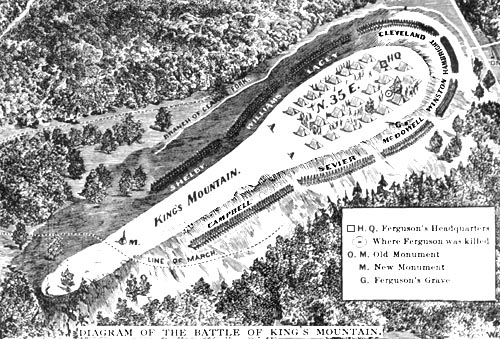Impaled by bayonet and concealed by the powder smoke, Robert
Henry, a mere 16 years of age, was forced to lay prostrate and helpless as the
battle went back and forth at Kings Mountain on October 7, 1780.
The bayonet charges were a mainstay in the British army and
Major Patrick Ferguson had taught his loyalist troops well. With shouts of Huzzah to the King they fired
their muskets at close range and charged down the rocky portions of Kings Mountain
faster than the Mountain men could reload their rifles.
Through the understory of sourwood, dogwood and rhododendron
the two armies sought out each other to kill.
Robert Henry’s leader, Major Chronicle, fell mortally wounded at
the head of his warriors. He was heard yelling, "Face to the hill!" just before he was shot down. Several other men in Henry's militia from Lincoln County would meet a like fate as they turned upwards to meet the enemy.
They were nearing the top of the rise when Ferguson’s
men surged towards them.
Robert Henry was able to kill the red coated soldier coming for him at the last
moment, but not before the bayonet skewered him through his hand and into his
thigh. He was immobilized and helpless
as the powder smoke hung heavy in the air. So, he waited in agony and feared
that he might be discovered and finished off by another soldier of the
realm.
The British charged down the rocky hillside with professional skill. Henry’s fellow Patriots
would fire their rifles and race away only yards ahead of the cold steel;
buying time to reload.
Once their rifles had been recharged, the South Fork boys
returned and pursued the British back up the mountainside.
On the way back up Henry’s friend kicked him free of the bayonet- hurting more coming out than when it went in. Henry grabbed his rifle and followed after them up the steep bank.
For over an hour the fighting raged up and down the mountain
on all sides. Then the Patriots rolled up and over the mountain and pushed the red coats into a tight circle, east of their encampment.
Lt. Hambright, who took command after Major Chronicle went down, was wounded a stone's throw away from where British Major Ferguson was killed. Within sight of each other, each had shouted "Huzzah!" as they urged their men to fight.


The battle was won and the next day the prisoners were marched away.
Robert Henry stared down the Grim Reaper and shared in the glory of the victory that autumn day. He was carried to his nearby home to heal.
At home, a day or so after the battle, Henry and his two escorts were visited by Tories in disguise. These Tories immediately took information of the defeat of Major Ferguson to Lord Cornwallis and rumors of a mighty Patriot army in the west caused great concern.
Cornwallis retreated out of Charlotte. His troops spent restless nights on the road after being misdirected by local guides. He set up winter camp in Winnsboro, SC to lick his wounds.
Here, at Kings Mountain, a lowly 16 year old private fought the greatest nation in the known world on some of the hottest contested ground in the war. He would turn with others to face a precipice fortified by one of the King's fittest soldiers. Within an hour's time, he was charged in anger with bullet and blade and was impaled and left for dead. He was then rescued and gave battle to the enemy until victory was won.
In a moment when a fledgling nation was only a hope and the life of a teenager was only fodder for tyranny's sake, Robert Henry measured up to his rite of passage.
Freedom Reigns!
King’s Mountain and Its Heroes: History of the Battle of Kings
Mountain, October 7th, 1780, and the Events Which Led to It, Lyman
Draper
http://www.shelbystar.com/article/20150707/news/150709147
http://www.greatdreams.com/henry/robert-henry.htm
https://www.citizen-times.com/story/news/local/2018/02/18/visiting-our-past-revolutionary-boyhood-robert-henry/342500002/

























